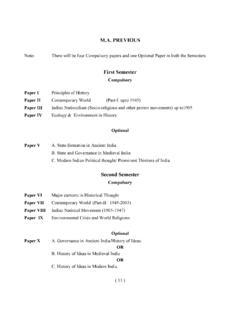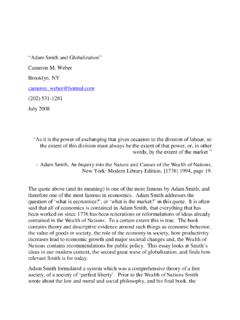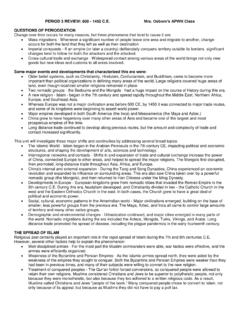Transcription of Sovereign Development Funds - OECD
1 OECD Emerging Markets Network Working Paper Sovereign Development Funds : Key financial actors of the shifting wealth of nations Javier Santiso Director, OECD Development Centre Chair, OECD Emerging Markets Network (EmNet) Working Paper October 2008 2 Abstract The emergence of Sovereign Wealth Funds (SWF) has signaled a major reshaping of the world s economy: financial actors from developing countries playing on an equal footing with the financial giants of OECD countries. Rising financial centers such as Singapore, Dubai or Shanghai have nurtured leading financial institutional and asset managers independent of the traditional Western financial centers of New York, Boston or London.
2 Beyond this spectacular emergence also lies promising news for the wealth of (developing) nations. Sovereign wealth Funds may grow to become major actors of Development finance: Sovereign Development Funds . Should SWFs allocate 10% of their portfolio to other emerging and developing economies over the next decade, this could generate inflows of USD 1 400 billion: a yearly amount higher than all OECD countries Development aid put together. The international investment of Sovereign Funds is already increasing. If domestically, some Sovereign wealth Funds tend to behave as Development finance institutions, working to boost economic diversification or build strong national champions, in their international investment strategies their behavior resembles traditional investment Funds , seeking performance and solid returns.
3 This article will first discuss the emergence of these institutions (which are not totally new) and follow by assessing their potential impact in other emerging markets. We conclude by arguing that Sovereign Funds , because of their origins (emerging economies for most of them) and their potential (or already effective) re-positioning towards emerging markets could usefully be considered as Sovereign Development Funds (SDF). Keywords: Sovereign wealth fund , diversification, emerging markets JEL: F30, O16, P16 We would like to acknowledge for the comments, documents shared, insights, comments and suggestions, Rolando Avenda o, Jaime Caruana, Jorge Chirino, Benoit Coeur , Chlo Coussen Dauban, Arnab Das, Thomas Dickinson, Manuel Gonz lez Cid, Goeril Havro, Stephen King, Gerard Lyons, Sebasti n Nieto Parra, Sayasat Nurbek, Eric Parrado, Avinash Persaud, Helmut Reisen, Malan Rietveld, Andrew Rozanov and Shuilin Wang.
4 All the errors and opinions here developed are obviously the sole responsibility of the author. This paper is based on a previous research and presentations see, in particular, Javier Santiso, Sovereign Development Funds : are SWFs a stability factor for the unwinding of global imbalances? , Presentation prepared for The Reinventing Bretton Woods Committee Conference Bretton Woods II under stress? , Banco de Espa a, Madrid, April 2008; and also Javier Santiso, Sovereign Development Funds , Presentation prepared for the OECD Emerging Markets Network, Paris, OECD, March 2008. See also and 3 : Emerging and developing countries contribution to global output growth Source: OECD Development Centre, 2008; based on IMF data : Emerging markets share of world outward FDI Source: OECD Development Centre, 2008; based on UNCTAD, World Investment Report 2007.
5 Sovereign Wealth Funds and the Shifting Wealth of Nations. Through the emergence of Sovereign wealth Funds , we are witnessing a major rebalancing of the wealth of nations. In this sense, therefore, SWFs are part of a broader narrative, a tectonic shift to which decoupling , a popular buzzword in the financial markets over 2007 describing asymmetries of growth patterns experienced by OECD economies versus emerging ones (for a discussion see for example Pimco, 2008), does little justice. Decoupling belongs in fact to a world that is already disappearing, one where a Periphery splits from a Centre. In fact, the real issue is that the Centre is less and less the Centre and the Periphery less and less the Periphery. Classifications such as OECD / emerging economies have grown to reflect historical baggage more than economic reality: Mexico, South Korea or Turkey, three leading emerging markets, are already OECD members; still others, such as Chile or Russia, are on accession track.
6 World growth today is no longer driven by OECD countries but from emerging ones (see Figure 1). OECD countries, which five decades ago concentrated 75% of world GDP, today account for less than 55% of global wealth. The stock market accounts for 35% and falling of world market capitalization, from 50% just 10 years ago. In 2007, the share of foreign direct investment from OECD countries decreased to 85%, from nearly 100% in 1970 (see Figure 2). The same year, for the first time, emerging markets economies traded more between each other than with OECD countries, illustrating the major shifting of fortunes and south-south financial recycling of new wealth derived from the commodity bonanza (see HSBC, 2008).
7 This tectonic shift is particularly striking with regards emerging world corporations. Just to name some few Latin examples, a company like ImBev, born from the merger of Belgian and Brazilian brewers, is already an exotic bird representative of these new global emerging corporations: difficult to classify in either emerging market or OECD asset class. Cemex, the Mexican cement giant, is still headquartered in Monterrey but its strategic, financial and economic research centers are located in Spain. The profile of the Brazilian mining conglomerate Vale has already changed with the acquisition of Inco from Canada, and the pending deal on Swiss-based Xstrata should complete its transformation into a major global player.
8 Brazil is growing into a global trader, reaching into exotic markets like the Middle East, Africa or South East Asia. Companies like Vale, Petrobras or Odebrecht are entering actively in the African markets while Embraer and Marcopolo are becoming big players in 4 : Comparative levels of GDP Billion, 1990 USD Source: OECD Development Centre, 2008; based on Maddison, 2008 China1. These emerging global multilatinas, with headquarters in Latin America, are following a trend that includes India, China, Russia or South Africa based companies, to name but the largest. It is ironical, to see a company like Tata, emerging from India, to buy the jewels of the old Empire, acquiring one after another, Corus, Jaguar and Rolls Royce.
9 The Periphery is entering massively into the Centre. Of course, emerging markets were not always on the periphery of the world economy: in many cases it would be more accurate to talk about re-emerging rather than emerging markets. China is probably the most spectacular case in point: till the mid-nineteenth century, it represented over 30% of world GDP, gradually slipping over the following hundred years (in 1950 dropping to less than 5% of world GDP - see Figure 3). In other words, not everything is new under the sun, China is re-assuming a leading role in terms of weight in the world economy, the big difference between then and now is that this re-emergence is taking place in a very different way, China being much more open and plugged into the world economy that it has been ever been before.
10 According to Angus Maddison s calculations, in a recent book published by the OECD Development Centre2, China will regain its place as the first world economy in terms of GDP by 2015 (see Figure 4). The recent revision of World Bank PPP data notwithstanding, China is poised to reclaim its place as the world s largest economy over the next half century. What is true for China is also valid for other emerging economies, particularly India that also weighed heavily in the world economy until the late XIXth Century and is now also re-emerging (see Figure 5). These Asian Drivers are today impacting the entire developing world (see Avenda o, Reisen, and Santiso, 2008), as much as developed economies, becoming net exporters of capital to the global economy.
















